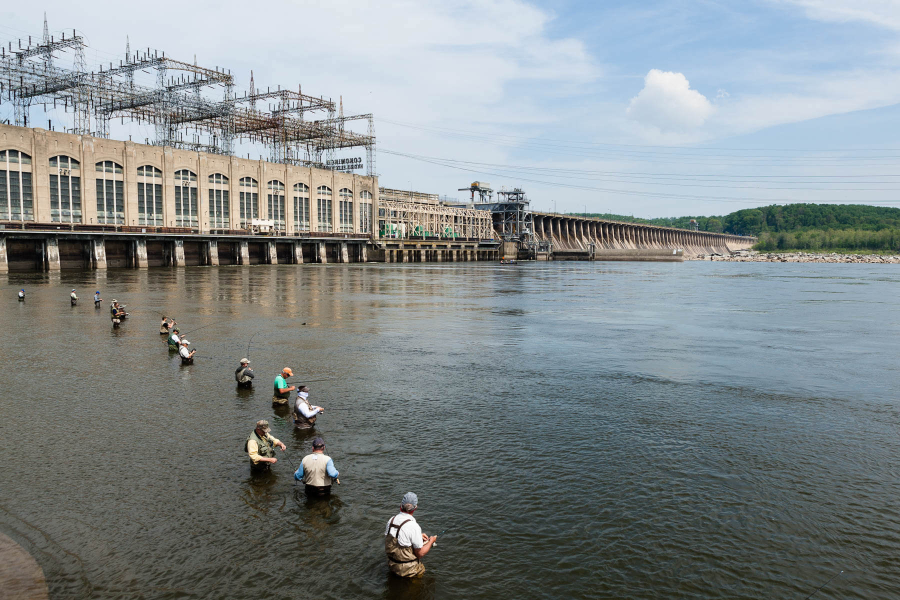Long-awaited Conowingo plan begins to take shape
Funds awarded to help address financing, oversight of Conowingo WIP

For the past few years, the Chesapeake Bay Program partnership has been grappling with the question, “Who is responsible for the Conowingo Dam?” The long-awaited answer is: we all are.
The issue with Conowingo Dam
While the Conowingo Dam lies in Maryland and is owned by the Exelon Corporation, it sits on the Susquehanna River which flows downstream from New York and Pennsylvania.
Since its construction, the reservoir behind the dam has captured sediment—and the nutrients that are often attached—flowing down the Susquehanna River, reducing the amount of nutrient and sediment pollution entering the Chesapeake Bay.
While the reservoir has long served as an effective way to control pollution, a 2015 report by the U.S. Geological Survey estimated that the reservoir had reached 92% capacity. Another report, this one by the Lower Susquehanna River Watershed Assessment team, confirmed that the reservoir located behind the dam had essentially become full and was trapping smaller and smaller amounts of sediment.
If the reservoir is unable to trap sediment, it will flow downstream into the Chesapeake Bay, often carrying nutrient pollution and chemical contaminants, which can reduce water clarity and dissolved oxygen. Extreme weather creates an even stronger impact. During the record-breaking rainfall in 2018, many of the dam’s gates were opened to relieve pressure, sending large amounts of debris and pollution downstream at a rapid pace.
Addressing additional pollutant loads
It took a partnership to address such a complex issue. The Chesapeake Bay Program Principals’ Staff Committee decided in early 2018 that a steering committee made up of representatives from each watershed jurisdiction (Delaware, Maryland, New York, Pennsylvania, Virginia, West Virginia and the District of Columbia) and the Chesapeake Bay Commission, would oversee the development of a watershed implementation plan (WIP) and financing strategy that would be specifically aimed at addressing the additional pollutant loads flowing into the Chesapeake Bay as a result of the reservoir no longer trapping sediment. The Environmental Protection Agency (EPA) would provide oversight in the development and implementation of the WIP, evaluate and track progress, and provide funding support through grants.
Fast forward a year and a half later, and the work is underway. In coordination with the watershed jurisdictions, the EPA recently announced that it awarded nearly $600,000 for three projects to further the Conowingo WIP. About $200,000 of that amount comes from EPA grants provided to watershed jurisdictions for their Chesapeake Bay restoration work.
- The Center for Watershed Protection will facilitate the development and implementation of the Conowingo WIP and associated two-year milestones of progress.
- The Chesapeake Bay Trust will develop a comprehensive financing strategy and associated investment plan that will involve public, non-profit and private funds to achieve the greatest pollution reduction while maximizing economic development.
- The Chesapeake Conservancy will track, verify and report on the implementation of the Conowingo WIP and its two-year milestones.
Bryan Seipp, project manager from the Center for Watershed Protection, noted that “addressing the increasing nutrient and sediment loads to the Chesapeake Bay as a result of the Conowingo Dam… is a complex and challenging task.”
A WIP includes detailed, specific steps that will be taken to reduce pollution, and the Conowingo WIP will be separate from the ones that each watershed jurisdiction submitted in August 2019. Under the Chesapeake Bay Total Maximum Daily Load, each watershed jurisdiction has a unique pollutant reduction target to meet by 2025, and they report on the progress they are making toward meeting their milestones every two years. The Conowingo WIP will follow the same process.
Maryland Governor and Chesapeake Executive Council Chair Larry Hogan congratulated the “impressive awardees and their partners.”
“We all benefit from innovative partnerships to protect and restore the Chesapeake Bay” said Hogan.
Learn more about the Conowingo Dam.

Comments
Totally agree with the gentleman below with the addition that, with so many entities involved and the expectation that the TMDL can be met, which is absurd, means that the project -whenever it gets started- is doomed to being years longer and billions of dollars in cost more than it should be and than is necessary. Face it, stirring up the muck at the base of the dam is going to result in an appreciable amount getting sent over and down to the bay. Why not default to this result, place recovery and mitigation efforts immediately downstream ,get in there and quickly (not to be confused with sloppily or hap-haphazardly) extract the sediments? Otherwise this will be another political boondoggle doomed to end up in the courts and the dam will still be full. We may have to accept diminished Bay water quality and clarity for the life of the project (=short term) but the long term gains are worth it. Furthermore, near site temporary or even permanent storage and settlement sites should be identified (if any) and used - especially should an emergency arise.To expect the project to be completed without any spillage is unrealistic.
Who is responsible for the Susquehanna watershed and pollutants coming from it? That's my question. Maybe more could be done to clean up the watershed rather than catching it at the damn.
You have too many hands in the fire already.
I suggest that you dredge the river haul the debris by rail car north to Brunner Island they have a de-watering facility and then burn the solids.
Thank you!
Your comment has been received. Before it can be published, the comment will be reviewed by our team to ensure it adheres with our rules of engagement.
Back to recent stories